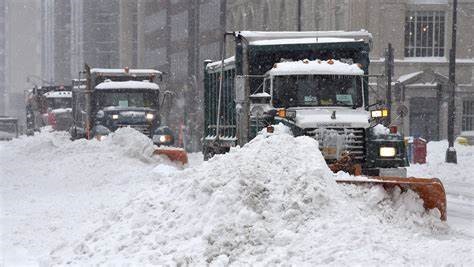
Snowplows are a vital service to ensure the safety of our community. Many drivers have adopted to snowy road conditions, yet they remain uncertain when they encounter a snowplow. Snowplows are generally equipped with a large, heavy plow on the front, which allows them to clear ice and snow from the roads. In addition to the plow on the front, many snowplows are equipped with attachments such as wing plows and towplows that stick out several feet. Snowplows may cross the centerline, the shoulder of the road, or make other unpredictable maneuvers to thoroughly clear roads, so it is important for everyone on the road to know what to do when they encounter a snowplow. Here are three commonly asked questions about sharing the road with a snowplow:
- How far back should one stay from a snowplow?
The general rule of thumb is to stay ten full car lengths, or about 175 feet, from a snowplow. This distance varies based upon weather and road conditions, but it is always a good idea to give extra room. Allowing extra space from the car in front of you does not only apply to snowplows, but all vehicles on the road due to increased brake time. Snowplows need more space than other vehicles because of unexpected stops and reduced visibility. Be aware of your surroundings and prepare for the unexpected. - What are some things to watch for when driving behind a snowplow?
Snowplows are typically spreading rock salt or some type of road deicer. This is another reason to keep proper distance from a snowplow; if you are too close, deicing product has the potential to damage your vehicle. Snowplows may create a cloud of snow that reduces your visibility. It is important to look for snow clouds to avoid the possibility of concealed objects in your path. - Is it safe to pass a snowplow?
Situations in which it is safe to pass a snowplow vary. If you feel it is safe to pass a snowplow, first look for the ‘wing plow’. The wing plow is a 10-12-foot extension, typically to the right side of the vehicle, which allows the snowplow to clear snow and ice. It is never safe to pass a plow on the right side because of the wing plow. To avoid the wing plow, it is best to pass on the left and leave plenty of room. Be sure to allow distance before cutting back into the snowplow's lane, as their blades extend several feet in front of the vehicle. Keep your eye out for snowplows driving in tandem (side-by-side), as it increases the danger of passing. It is not recommended to pass snowplows working in tandem.
 Graphic by MaineDOT
Graphic by MaineDOT
Snowplow operators want to go home to their families and they want you to get home to yours. Overall, remember to drive slowly, give other cars plenty of space, and be aware of your surroundings! Please do not crowd the plow. The EnviroTech Services, Inc. family is happy to provide tips and information to help you stay safe.
For more tips about snow plow etiquette, click here.
Works Cited
Jones, Meghan. “Here's Exactly What to Do When You Spot a Snow Plow on the Road.” Reader's Digest, Reader's Digest, 25 Feb. 2020, www.rd.com/article/driving-with-snow-plow/
“Safe Travel around Snowplows - Transportation Matters for Iowa: Iowa DOT.” Transportation Matters for Iowa | Iowa DOT, www.transportationmatters.iowadot.gov/2017/12/safe-travel-around-snowplows.html.

